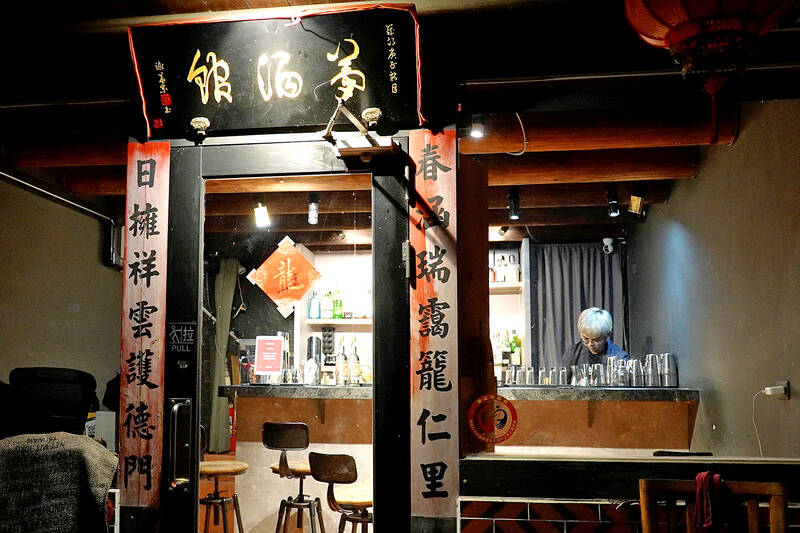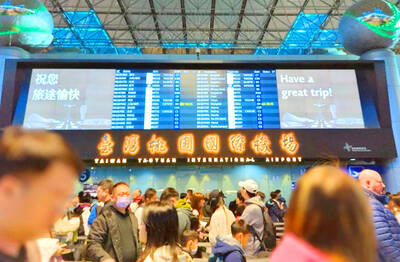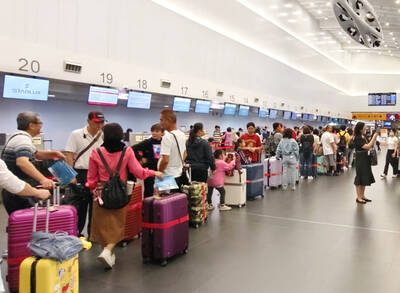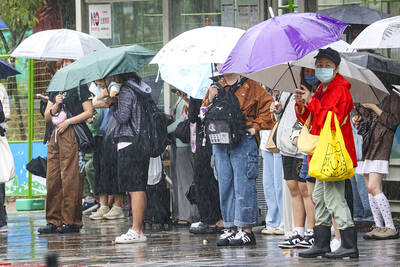On Kinmen Island, less than an hour’s boat ride from the cities of Xiamen and Quanzhou in China’s Fujian Province, bar owner Powei Lee draws crowds by blending the tiny island’s battle-scared past into cocktails.
During the height of the Cold War, Chinese and Taiwanese forces regularly clashed over Kinmen — then mostly known in English as Quemoy — and other islets controlled by Taiwan along China’s coast.
While today Kinmen is a fashionable tourist destination, drawing visitors to see its endangered otters and stark natural beauty, it has been back in the news after China last week included areas round the island for its latest war games near Taiwan.

Photo: Joyce Zhou, Reuters
Kinmen native Lee’s cocktails at his Vent Bar showcase Kinmen’s unique flavor, such as the local fire water, kaoliang, made with sorghum grown on the island.
Lee, 31, has designed one cocktail inspired by an extensive propaganda campaign that followed fighting in 1958, when Taiwanese forces fended off a Chinese attack on Kinmen, whose closest point is only about 2km from China.
Called “Pick and Eat,” the cocktail is made with a base of soy milk, ginger and whiskey, topped with cookies.
“Back then, the two sides would drop propaganda leaflets, each trying to show that their side was doing better and urging the other to surrender,” he said.
“One of the things they would do besides the leaflets was to send over supplies like snacks and food, to show that the people were well-fed.”
Taiwan has controlled Kinmen, and the Matsu islands further up the coast, since the defeated Republic of China government fled to Taipei in 1949 after losing a civil war with Mao Zedong’s (毛澤東) communists.
Old bunkers, many now open to visitors, still dot Kinmen which is home to about 100,000 people, and Taiwan’s military maintains a substantial presence.
“I want them [the visitors] to be able to take away something even more meaningful than just typical souvenirs. If they can really feel that connection to the land, and understand the stories behind it, that’s going to be the best memento they can have from their time here in Kinmen,” Lee said.
Those visitors might be Taiwanese or from further afield — but generally not Chinese. Regular post-COVID-19-pandemic Chinese tourism to Taiwan has yet to resume, amid bickering between Beijing and Taipei.
Life in Kinmen continued largely as normal during the drills last week, residents said, and flights to and from Taiwan proper were not disrupted.
Regarding the potential for conflict, Lee said he hoped he would not see war.
“The pandemic has already been very disruptive, and a real war would be far worse,” he said.

Foreign travelers entering Taiwan on a short layover via Taiwan Taoyuan International Airport are receiving NT$600 gift vouchers from yesterday, the Tourism Administration said, adding that it hopes the incentive would boost tourism consumption at the airport. The program, which allows travelers holding non-Taiwan passports who enter the country during a layover of up to 24 hours to claim a voucher, aims to promote attractions at the airport, the agency said in a statement on Friday. To participate, travelers must sign up on the campaign Web site, the agency said. They can then present their passport and boarding pass for their connecting international

Three Taiwanese airlines have prohibited passengers from packing Bluetooth earbuds and their charger cases in checked luggage. EVA Air and Uni Air said that Bluetooth earbuds and charger cases are categorized as portable electronic devices, which should be switched off if they are placed in checked luggage based on international aviation safety regulations. They must not be in standby or sleep mode. However, as charging would continue when earbuds are placed in the charger cases, which would contravene international aviation regulations, their cases must be carried as hand luggage, they said. Tigerair Taiwan said that earbud charger cases are equipped

Temperatures in northern Taiwan are forecast to reach as high as 30°C today, as an ongoing northeasterly seasonal wind system weakens, the Central Weather Administration (CWA) said. CWA forecaster Tseng Chao-cheng (曾昭誠) said yesterday that with the seasonal wind system weakening, warmer easterly winds would boost the temperature today. Daytime temperatures in northern Taiwan and Yilan County are expected to range from 28°C to 30°C today, up about 3°C from yesterday, Tseng said. According to the CWA, temperature highs in central and southern Taiwan could stay stable. However, the weather is expected to turn cooler starting tonight as the northeasterly wind system strengthens again

COOLING OFF: Temperatures are expected to fall to lows of about 20°C on Sunday and possibly 18°C to 19°C next week, following a wave of northeasterly winds on Friday The Central Weather Administration (CWA) on Sunday forecast more rain and cooler temperatures for northern Taiwan this week, with the mercury dropping to lows of 18°C, as another wave of northeasterly winds sweeps across the country. The current northeasterly winds would continue to affect Taiwan through today, with precipitation peaking today, bringing increased rainfall to windward areas, CWA forecaster Liu Pei-teng (劉沛滕) said. The weather system would weaken slightly tomorrow before another, stronger wave arrives on Friday, lasting into next week, Liu said. From yesterday to today, northern Taiwan can expect cool, wet weather, with lows of 22°C to 23°C in most areas,